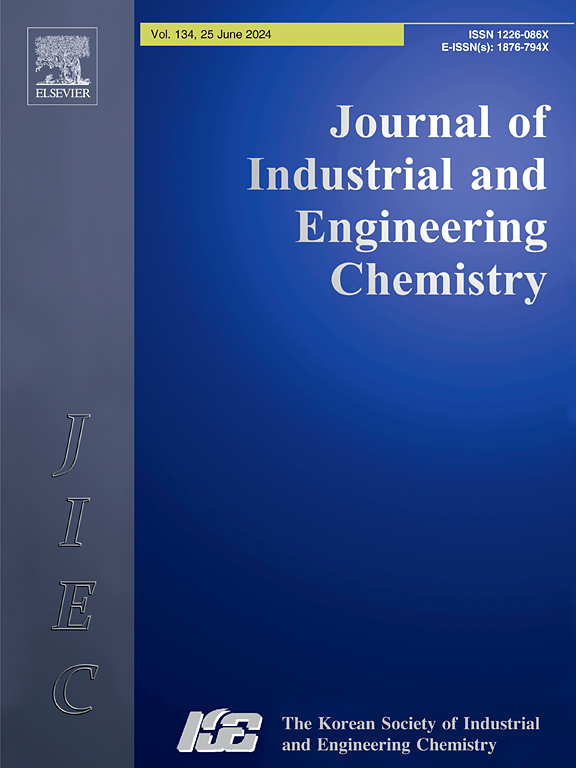Bioabsorbable PLA/PHA composite pins for orthopedic applications: In vitro and in vivo study
IF 5.9
3区 工程技术
Q1 CHEMISTRY, MULTIDISCIPLINARY
Journal of Industrial and Engineering Chemistry
Pub Date : 2025-03-14
DOI:10.1016/j.jiec.2025.03.023
引用次数: 0
Abstract
Poly(lactic acid) (PLA) is a bioabsorbable polymer that is commonly used in orthopedic implants. However, PLA implants can refracture owing to their inherent brittleness and inflammation caused by their acidic degradation products. Polyhydroxyalkanoates (PHAs) are biodegradable polyester derived from microorganisms. Some types such as poly (4-hydroxybutyrate) (P4HB), can be molded and processed at 150 ℃. PHAs can exhibit semi-crystalline or amorphous properties, depending on their composition and structure. Furthermore, PHA can be blended with PLA to enhance the stability and flexibility of the implant. In this study, we fabricated a pin-type implant composed of poly(3-hydroxybutyrate-co-4-hydroxybutyrate) (P3HB-4HB) using injection molding and investigated their applicability as an orthopedic implant through in vitro and in vivo tests. Remarkably, the PLA/PHA pin did not exhibit cytotoxicity in in vitro experiments using MC3T3-E1cells. A rat model of long bone fracture was used for the in vivo study. Overall, the brittleness of the conventional PLA was decreased by blending it with P3HB-4HB (PHA). In vivo studies revealed that the bone union rate of PLA/PHA pins was higher than that of PLA pins. The prepared PLA/PHA composite pin offers superior mechanical properties and enhanced bone healing, making them a promising implant for orthopedic applications.

用于骨科应用的生物可吸收PLA/PHA复合针:体外和体内研究
聚乳酸(PLA)是一种生物可吸收的聚合物,通常用于骨科植入物。然而,由于其固有的脆性和酸性降解产物引起的炎症,PLA植入物可能会重复断裂。聚羟基烷酸酯(PHAs)是一种由微生物产生的可生物降解聚酯。某些类型如聚(4-羟基丁酸酯)(P4HB)可在150℃下成型和加工。相化合物可以表现出半晶或非晶的性质,这取决于它们的组成和结构。此外,PHA可以与PLA混合以增强植入物的稳定性和柔韧性。本研究采用注射成型的方法制备了聚(3-羟基丁酸酯-co-4-羟基丁酸酯)(P3HB-4HB)针状种植体,并通过体外和体内试验研究了其作为骨科种植体的适用性。值得注意的是,在mc3t3 - e1细胞的体外实验中,PLA/PHA pin没有表现出细胞毒性。采用大鼠长骨骨折模型进行体内研究。总体而言,通过与P3HB-4HB (PHA)共混,降低了常规PLA的脆性。体内研究显示PLA/PHA钉的骨愈合率高于PLA钉。制备的PLA/PHA复合引脚具有优异的机械性能和增强的骨愈合能力,使其成为骨科应用的有前途的植入物。
本文章由计算机程序翻译,如有差异,请以英文原文为准。
求助全文
约1分钟内获得全文
求助全文
来源期刊
CiteScore
10.40
自引率
6.60%
发文量
639
审稿时长
29 days
期刊介绍:
Journal of Industrial and Engineering Chemistry is published monthly in English by the Korean Society of Industrial and Engineering Chemistry. JIEC brings together multidisciplinary interests in one journal and is to disseminate information on all aspects of research and development in industrial and engineering chemistry. Contributions in the form of research articles, short communications, notes and reviews are considered for publication. The editors welcome original contributions that have not been and are not to be published elsewhere. Instruction to authors and a manuscript submissions form are printed at the end of each issue. Bulk reprints of individual articles can be ordered. This publication is partially supported by Korea Research Foundation and the Korean Federation of Science and Technology Societies.

 求助内容:
求助内容: 应助结果提醒方式:
应助结果提醒方式:


